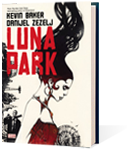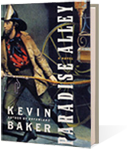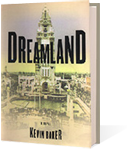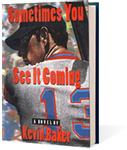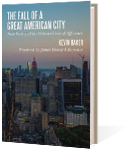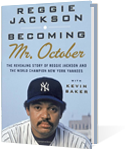By Shaun O’Connell
East side, west side, the fantasy of New York
At the turn into this century, New York City was raucous and rapacious. By 1900 some 3.5 million people, a third of them foreign-born, lived in Greater New York. Each sought the American dream in a tough city of sharp contrasts, from the “Millionaires’ Row” of the moneyed “400” along Fifth Avenue to the teeming tenements of the new immigrants on the Lower East Side. Writers just before and after 1900 strained to contain the city’s extravagance and indifference.
Some composed redemptive tales. Horatio Alger’s fiction about newsboys, or “Street Arabs,” reassured readers that pluck and luck would lead to success. O. Henry’s tricky stories about “The Four Million,” as he named the city’s common residents in a collection, showed the city had a heart.
But most serious writers portrayed New York as a killing ground. In fiction and poetry, parables of disillusionment and death were shaped by Stephen Crane, Theodore Dreiser, Edith Wharton, Hart Crane, John Dos Passos, and many more. Henry James, returning in 1904 to the city of his birth, was so appalled by the pushy people, the soaring skyscrapers, and the garish hotels that he waxed hyperbolic: “The city has the air and movement of hysteria.” Now Kevin Baker, in Dreamland,a high-spirited and knowing saga of the city in the early years of this century, adds his own fictional air and movement of hysteria to the lengthy record of those who have sought to make language match the magnificence and the misery of New York, “the city that never sleeps.”
More nightmare than dreamscape, Dreamland opens by assembling many of its main characters at a rat pit. “They all filed down into the basement; bummies and gangsters, shopkeepers and family men; and a few drunken sports out on a tear.” They are gathered to bet on the time it would take a dog to kill 100 rats, released into the pit 10 at a time. Not satisfied with this grisly roulette, customers made side bets to see if Gyp the Blood, a low-life criminal, could break the back of a randomly chosen human victim over his knee-“right, left, and right again; three distinct cracks louder than pistol shots reverberated through the room”-leaving him twitching like a fish on the dirt floor.
Baker’s story kicks into high gear when Kid Twist, a crook with a heart of gold, bashes Gyp’s head with a rat collector’s shovel, trying to rescue a newsboy from paralysis. But Kid discovers he has instead saved Trick, a dwarf dressed in boy’s clothing. When Gyp and his gang chase Kid and Trick, the novel is off and running, like one of those early silent comedies filmed in the city.
They hide in Dreamland, one of three Coney Island amusement parks that feature freak shows, dwarfs, diving horses, hootchy-kootchy dancers, murderers, and poets. Dreamland serves as Baker’s central metaphor for an exotic city, for an extravagant and surreal age. Trick thinks, “How could you walk through the hissing, gleaming phantasmagoria that were Dreamland and Luna Park, and Steeplechase; past all the electrical wonders, and the exotic tribesmen; the death-defying rides, and the tiny babies fighting for their lives in their incubators-and not believe in anything at all?”
Through Dreamland and into lower Manhattan pass a number of representative men and women, fighting each other for their lives: Esther, a rabbi’s daughter who works in the Triangle, a sweatshop on the Lower East Side; Big Tim Sullivan, a Tammany politician; various colorful con men, freaks, dwarfs, strikers, prostitutes, pols, and panders. Even Sigmund Freud and Carl Jung make cameo appearances. (Freud, amazed, watches Charlie Chaplin cavort on film at the New Amsterdam roof garden.) Dreamlandthe novel, like the amusement park, attracts all kinds.
Like so many New York tales that turn on juxtaposition, Dreamlandmixes romance, crime, politics, and victimization, in alternating story lines. Kid falls for Esther and Trick for Mad Carlotta, another dwarf. Lovers, tailed by assassins, pursue each other through darkened streets. Meanwhile, Big Tim and the other Tammany sachems dine high off the hog at Delmonico’s and feed on the citizens they claim to represent. “Jobbers and the grafters; men with connections, or an angle” make out, but “the other half” and more are squeezed into tenements, work long hours, and die young.
The novel that commences at a rat pit concludes at an infamous fire. The Triangle sweatshop burned on March 25, 1911: 146 people were killed in 15 minutes, most of them girls and young women working for $2 a day, making shirtwaists. Thus farce climaxes as tragedy.
Kevin Baker has written a baseball novel (Sometimes You See It Coming,1992), and is working on a book about the Red Sox-Yankees rivalry. He has also served as chief historical researcher on Harry Evans’s book The American Century.So I conclude he has a proper sense of values and knows what he is talking about. Dreamlandis clearly inspired by E. L. Doctorow’s campy fictional treatment of New York City history, Ragtime.Baker lacks Doctorow’s range of representation and quirky style, but Dreamlandis at once instructive and great good fun to read. Baker is particularly strong on period-piece details, like his description of Irish saloons with starched white tablecloths, pickled eggs, and the ubiquitous painting of Custer’s Last Stand over the bar. He also knows the street lingo: “how to run a stuss game, and the banco scam, and the drop scam; and the mysterious art of how to render a man senseless by tapping a cigar ash in his beer.”
Like the amusement park it describes, this novel presents itself brightly lit and promises great expectations. No doubt Baker knows that grand old song, “Meet me tonight in Dreamland / Sweet dreamy Dreamland / There let my dream come true.” Many readers of Dreamlandwill enjoy singing along. I’m still humming a few bars, myself.
By Shaun O’Connell
East side, west side, the fantasy of New York
At the turn into this century, New York City was raucous and rapacious. By 1900 some 3.5 million people, a third of them foreign-born, lived in Greater New York. Each sought the American dream in a tough city of sharp contrasts, from the “Millionaires’ Row” of the moneyed “400” along Fifth Avenue to the teeming tenements of the new immigrants on the Lower East Side. Writers just before and after 1900 strained to contain the city’s extravagance and indifference.
Some composed redemptive tales. Horatio Alger’s fiction about newsboys, or “Street Arabs,” reassured readers that pluck and luck would lead to success. O. Henry’s tricky stories about “The Four Million,” as he named the city’s common residents in a collection, showed the city had a heart.
But most serious writers portrayed New York as a killing ground. In fiction and poetry, parables of disillusionment and death were shaped by Stephen Crane, Theodore Dreiser, Edith Wharton, Hart Crane, John Dos Passos, and many more. Henry James, returning in 1904 to the city of his birth, was so appalled by the pushy people, the soaring skyscrapers, and the garish hotels that he waxed hyperbolic: “The city has the air and movement of hysteria.” Now Kevin Baker, in Dreamland,a high-spirited and knowing saga of the city in the early years of this century, adds his own fictional air and movement of hysteria to the lengthy record of those who have sought to make language match the magnificence and the misery of New York, “the city that never sleeps.”
More nightmare than dreamscape, Dreamlandopens by assembling many of its main characters at a rat pit. “They all filed down into the basement; bummies and gangsters, shopkeepers and family men; and a few drunken sports out on a tear.” They are gathered to bet on the time it would take a dog to kill 100 rats, released into the pit 10 at a time. Not satisfied with this grisly roulette, customers made side bets to see if Gyp the Blood, a low-life criminal, could break the back of a randomly chosen human victim over his knee-“right, left, and right again; three distinct cracks louder than pistol shots reverberated through the room”-leaving him twitching like a fish on the dirt floor.
Baker’s story kicks into high gear when Kid Twist, a crook with a heart of gold, bashes Gyp’s head with a rat collector’s shovel, trying to rescue a newsboy from paralysis. But Kid discovers he has instead saved Trick, a dwarf dressed in boy’s clothing. When Gyp and his gang chase Kid and Trick, the novel is off and running, like one of those early silent comedies filmed in the city.
They hide in Dreamland, one of three Coney Island amusement parks that feature freak shows, dwarfs, diving horses, hootchy-kootchy dancers, murderers, and poets. Dreamland serves as Baker’s central metaphor for an exotic city, for an extravagant and surreal age. Trick thinks, “How could you walk through the hissing, gleaming phantasmagoria that were Dreamland and Luna Park, and Steeplechase; past all the electrical wonders, and the exotic tribesmen; the death-defying rides, and the tiny babies fighting for their lives in their incubators-and not believe in anything at all?”
Through Dreamland and into lower Manhattan pass a number of representative men and women, fighting each other for their lives: Esther, a rabbi’s daughter who works in the Triangle, a sweatshop on the Lower East Side; Big Tim Sullivan, a Tammany politician; various colorful con men, freaks, dwarfs, strikers, prostitutes, pols, and panders. Even Sigmund Freud and Carl Jung make cameo appearances. (Freud, amazed, watches Charlie Chaplin cavort on film at the New Amsterdam roof garden.) Dreamlandthe novel, like the amusement park, attracts all kinds.
Like so many New York tales that turn on juxtaposition, Dreamlandmixes romance, crime, politics, and victimization, in alternating story lines. Kid falls for Esther and Trick for Mad Carlotta, another dwarf. Lovers, tailed by assassins, pursue each other through darkened streets. Meanwhile, Big Tim and the other Tammany sachems dine high off the hog at Delmonico’s and feed on the citizens they claim to represent. “Jobbers and the grafters; men with connections, or an angle” make out, but “the other half” and more are squeezed into tenements, work long hours, and die young.
The novel that commences at a rat pit concludes at an infamous fire. The Triangle sweatshop burned on March 25, 1911: 146 people were killed in 15 minutes, most of them girls and young women working for $2 a day, making shirtwaists. Thus farce climaxes as tragedy.
Kevin Baker has written a baseball novel (Sometimes You See It Coming,1992), and is working on a book about the Red Sox-Yankees rivalry. He has also served as chief historical researcher on Harry Evans’s book The American Century.So I conclude he has a proper sense of values and knows what he is talking about. Dreamlandis clearly inspired by E. L. Doctorow’s campy fictional treatment of New York City history, Ragtime.Baker lacks Doctorow’s range of representation and quirky style, but Dreamlandis at once instructive and great good fun to read. Baker is particularly strong on period-piece details, like his description of Irish saloons with starched white tablecloths, pickled eggs, and the ubiquitous painting of Custer’s Last Stand over the bar. He also knows the street lingo: “how to run a stuss game, and the banco scam, and the drop scam; and the mysterious art of how to render a man senseless by tapping a cigar ash in his beer.”
Like the amusement park it describes, this novel presents itself brightly lit and promises great expectations. No doubt Baker knows that grand old song, “Meet me tonight in Dreamland / Sweet dreamy Dreamland / There let my dream come true.” Many readers of Dreamlandwill enjoy singing along. I’m still humming a few bars, myself.

